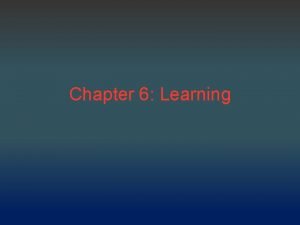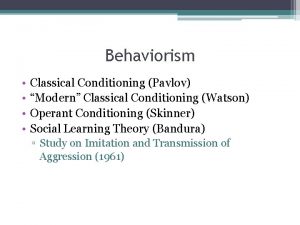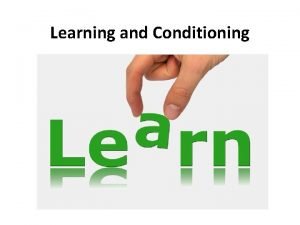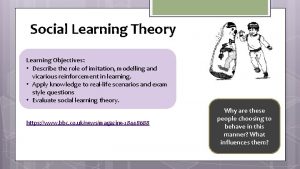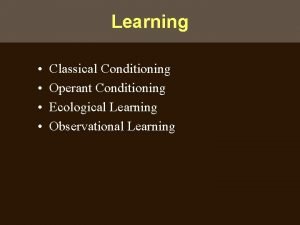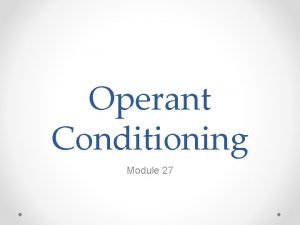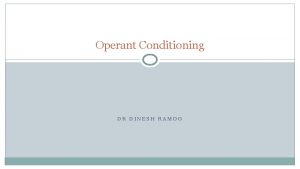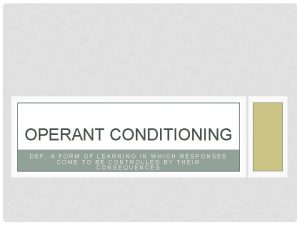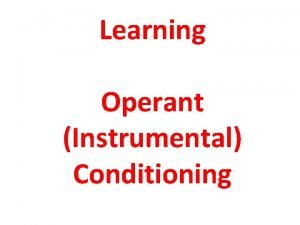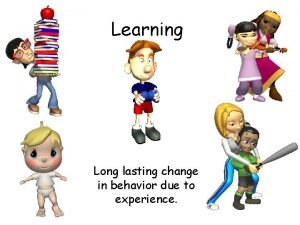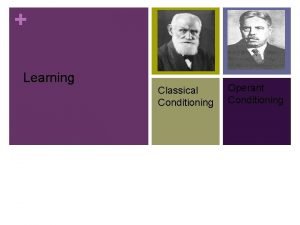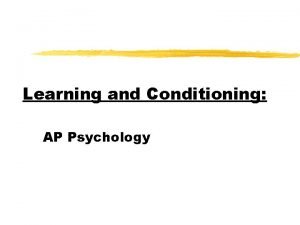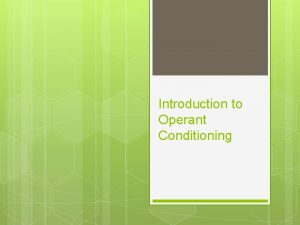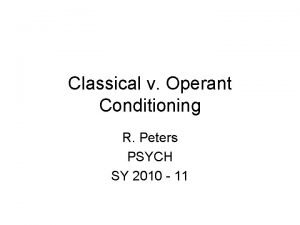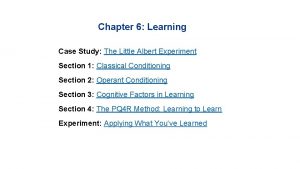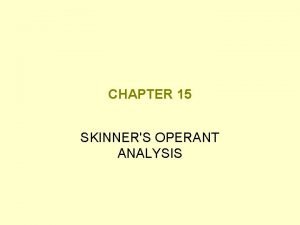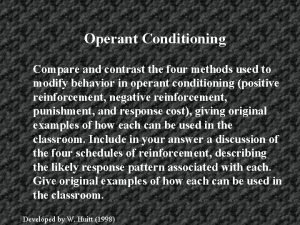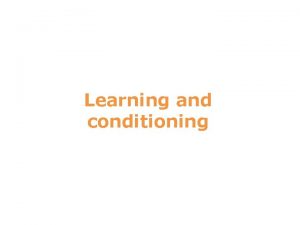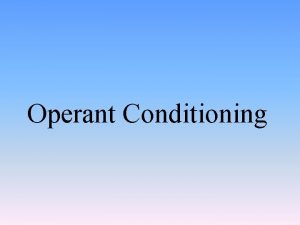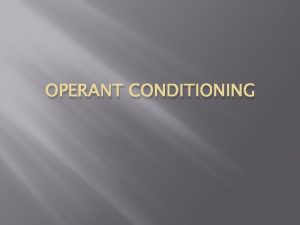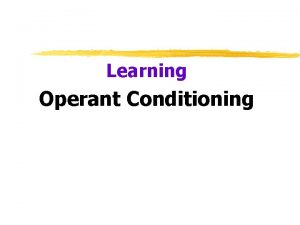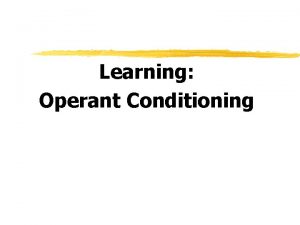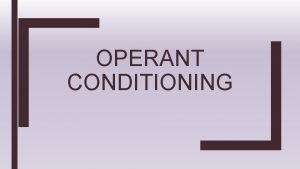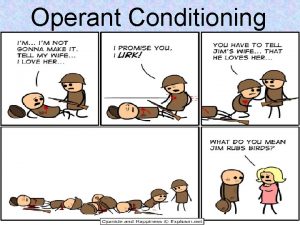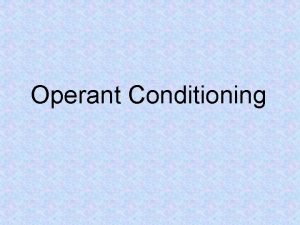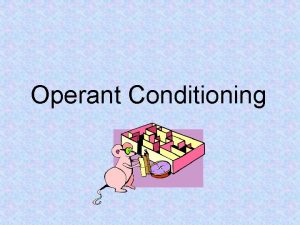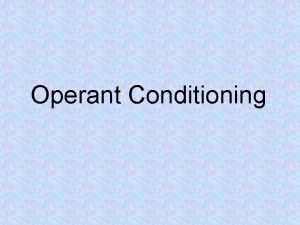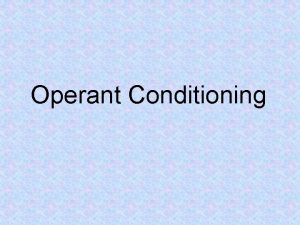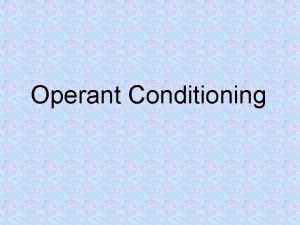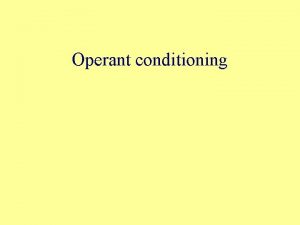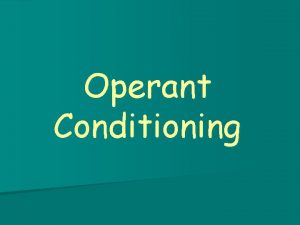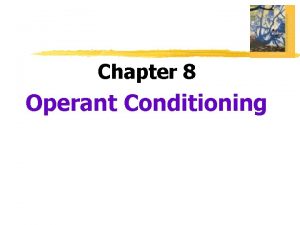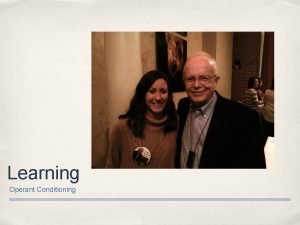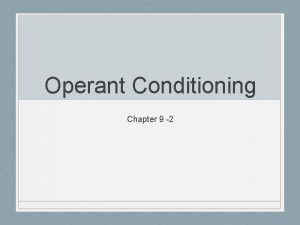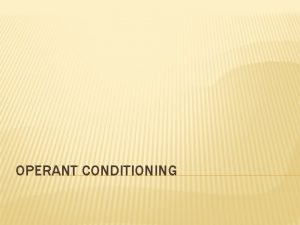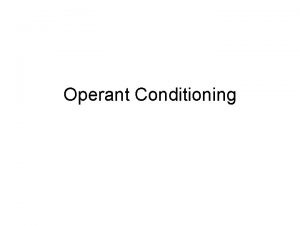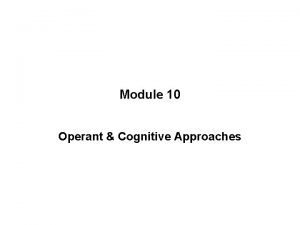Operant Conditioning Operant Conditioning A type of learning






























- Slides: 30

Operant Conditioning

Operant Conditioning • A type of learning in which behavior is strengthened if followed by reinforcement or diminished if followed by punishment.

Classical v. Operant • They both use acquisition, discrimination, spontaneous recovery, generalization and extinction. • Classical Conditioning is automatic (respondent behavior). Dogs automatically salivate over meat, then bell- no thinking involved. • Operant Conditioning involves behavior where one can influence their environment with behaviors which have consequences (operant behavior).

Is the organism learning associations between events that it doesn’t control? Classical Conditioning Is the organism learning associations between its behavior and resulting events? Operant Conditioning

Edward Thorndike • Law of Effect: – states that behaviors followed by positive consequences are strengthened, while behaviors followed by negative consequences are weakened • Trial and Error

Thorndike used a fish to entice cats to find their way out of a puzzle box through a series of maneuvers. The cats’ performance tended to improve with successive trials…law of effect. Thorndike’s Cat in a Puzzle Box If at first you don’t succeed….

B. F. Skinner • Principles and procedures – Skinner box – automated to record the animal’s bar presses and deliver food pellets – Skinner box is an efficient way to study how an animal’s ongoing behaviors may be modified by changing the consequences of what happens after a bar press – 3 factors in operant conditioning of a rat • a hungry rat will be more willing to eat the food reward • operant response: condition the rat to press the bar • shaping: procedure in which an experimenter successively reinforces behaviors that lead up to or approximate the desired behavior (successive approximations)

Shaping y la p g on P s g Pin icken ch Bo m pig ba eo rdie WW ns o r II f • A procedure in Operant Conditioning in which reinforcers guide behavior closer and closer towards a goal. Can you think of other examples?

Operant Conditioning Chamber

Shaping behavior with the Skinner Box • Shaping – Facing the bar • rat is put in box. • when rat finally faces the bar, food pellet is released • rat sniffs the food pellet – Touching the bar • rat faces and moves towards the bar • another pellet is released. • Rat eats then wanders. Returning to sniff for a pellet, another pellet is dropped into the cup. Rat places a paw on the bar and another pellet is released.

• Shaping – Pressing the bar • When rat touches bar pellet is released. Rat eats and then puts paws back on bar and gets another pellet. Wait for rat to now push bar then release pellet. • Rat soon presses bar over and over again to get pellets. • Rat’s behavior was reinforced as the rat leads up to, or approximates, the desired behavior of bar pressing

Basic terminology • Consequences – consequences are contingent on behavior • Reinforcement – consequence that occurs after a behavior and increases the chance that the behavior will occur again • Punishment – consequence that occurs after a behavior and decreases the chance that the behavior will occur again

Reinforcer • Any event that STRENGTHENS the behavior it follows. Two Types of Reinforcement: Positive and Negative

Positive Reinforcement • Strengthens a response by presenting a stimulus after a response.

Negative Reinforcement • Strengthens a response by reducing or removing an aversive stimulus.

Types of Reinforcers

Primary Reinforcer • An innately reinforcing stimulus – stimulus such as food, water, or sex, that is innately satisfying and requires no learning on the part of the subject to become pleasurable

Conditioned (Secondary) Reinforcer • A stimulus that gains it reinforcing power through its association with a primary reinforcer. • any stimulus that has acquired its reinforcing power through experience; secondary reinforcers are learned, such as by being paired with primary reinforcers or other secondary reinforcers

Immediate v. Delayed Reinforcers

Reinforcement Schedules refer to a programs or rules that determine how and when the occurrence of a response will be followed by a reinforcer

Continuous Reinforcement • Reinforcing the desired response every time it occurs. Quick Acquisition Quick Extinction

Partial Reinforcement • Reinforcing a response only part of the time. • The acquisition process is slower. • Greater resistance to extinction.

Fixed-ratio Schedules • A schedule that reinforces a response only after a specified number of responses. Example: I give cookie monster a cookie every FIVE times he sings “C is for cookie”.

Variable-ratio Schedule • A schedule of reinforcement that reinforces a response after an unpredictable number of responses. Example: I give Homer a donut at random times when he says “DOH!!!”

Fixed-interval Schedule • A schedule of reinforcement that reinforces a response only after a specified time has elapsed. Example: I give Bart a Butterfinger every ten minutes after he moons someone.

Variable-interval Schedule • A schedule of reinforcement that reinforces a response at unpredictable time intervals. Pop Quizzes

Punishment • An event that DECREASES the behavior that it follows. Does punishment work?

Practical Applications of Operant Conditioning • Programmed Learning – Based on shaping – Break tasks down into small steps • Reinforce immediately after task is completely correctly • Linear: move straight through the program • Branched: depending on your answer you may skip some material, move ahead, or be remediated until you get the correct answer – Teaching machines—give immediate feedback • “canned” lessons where students move at own pace • SRA programs • Computers today---Nova Net, Odyssey • Behavior modification at home, work, school or sports

Practical Applications • Biofeedback – Use of machines to control blood pressure, headaches, ulcers, hyperactivity in children

Criticisms of Skinner • Insisted that external influences shape behavior – Did not put a lot of faith in intrinsic motivation or biological predispositions • Critics say he dehumanized people • Critics see many of his experiments with animals as conditioning them to use a natural behavior in an unnatural way – Many psychologists insist that conditioning outside biological predisposition is not possible
 Difference between operant and classical conditioning
Difference between operant and classical conditioning Classical conditioning vs operant conditioning
Classical conditioning vs operant conditioning Deborah skinner
Deborah skinner Classical conditioning and operant conditioning
Classical conditioning and operant conditioning Classical conditioning vs operant conditioning
Classical conditioning vs operant conditioning Operant conditioning adalah
Operant conditioning adalah Secondary reinforcer
Secondary reinforcer Pavlov effect
Pavlov effect Classical conditioning vs operant conditioning
Classical conditioning vs operant conditioning Operant conditioning classical conditioning
Operant conditioning classical conditioning Social and learning theory
Social and learning theory Albert bandura operant conditioning
Albert bandura operant conditioning Observational learning classical and operant conditioning
Observational learning classical and operant conditioning Operant conditioning
Operant conditioning Thorndike puzzle box
Thorndike puzzle box Dinesh ramoo
Dinesh ramoo Fixed interval
Fixed interval Biological preparedness
Biological preparedness Fixed ratio
Fixed ratio Reinforcement schedules graph
Reinforcement schedules graph Shaping in operant conditioning
Shaping in operant conditioning Fixed ratio reinforcement schedule
Fixed ratio reinforcement schedule Insight learning ap psychology
Insight learning ap psychology Fixed ratio schedule example
Fixed ratio schedule example Example of operant conditioning
Example of operant conditioning Operant conditioning definition
Operant conditioning definition Secondary reinforcer
Secondary reinforcer Operant conditioning and personality
Operant conditioning and personality Law of effect
Law of effect Compare and contrast operant and classical conditioning
Compare and contrast operant and classical conditioning Counterconditioning psychology
Counterconditioning psychology







